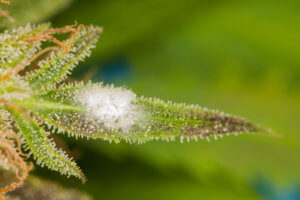Powdery mildew can be a huge source of pain for any grower. Once it has infected a garden, it can seem virtually impossible to get rid of. Luckily, there are a few ways to at least minimize the damage and risk of powdery mildew spreading from plant-to-plant throughout your cultivation facility.
Powdery mildew can be passed from Mother plants to clones, meaning that once a Mother plant is infected, all clones cut from her will carry powdery mildew. Even when physical signs are not present, an infected plant still harbors the fungus and, if used to create clones, will pass it onto the new plants. For this reason, it is important to attack powdery mildew at the source.
Learn More: The Biggest Takeaways From Our Instagram Q&A With Ed Rosenthal
Prevention in the Clone Room
The Clone Room provides the perfect environment for molds and fungus to thrive. The warm temperatures, high humidity and limited air flow in Clone Rooms combined with plants that have recently been cut and stressed out, left with no defenses, allows fungus, such as powdery mildew, to quickly spread.
To combat this, it is important to take a two-fold approach. Start by checking the Mother plant for signs of powdery mildew. If the Mother plant is infected, every clone cut from the plant will have powdery mildew. In order to prevent clones from inheriting powdery mildew from an infected Mother plant, the Mother needs to be replaced, allowing for a fresh start.

Air Sanitation
Secondly, air sanitation should be added to the Clone Room. As stated previously, the high temperatures and humidity common to Clone Rooms create perfect breeding conditions for powdery mildew. Reduce the risk by adding air sanitation to the room to clean pathogens, mold and fungus out of the air before they can spread to new plants. Ideally, air sanitation should be used in every room in a grow for this reason. Even if a plant does become infected, air sanitation can prevent powdery mildew from spreading to other plants in the room, making air sanitation a valuable addition to every room.

Other Ways to Prevent Powdery Mildew
In addition to replacing infected Mother plants and adding air sanitation to every room in the cannabis cultivation facility, there are a few other ways to prevent the spread of powdery mildew.
- Climate Control. Keep a close eye on temperature and humidity levels in cultivation rooms to avoid ideal conditions for powdery mildew to grow.
- Choose resistant strains. Some strains are less susceptible to powdery mildew than others. Choosing those that have a higher resistance level reduces the risk of powdery mildew spreading throughout a facility
- Keep tools clean. Using a pair of scissors that was previously used on a plant with powdery mildew is a great way to infect new plants. Always clean and sterilize tools before they are used on a different plant.
- Increase airflow within the plant canopy. Airflow within the canopy helps prevent humidity spikes and keeps the plant canopy the same climate at the rest of the grow room.
Prevention is the Best Solution
Overall, when treating powdery mildew, or any other airborne infestation, remember to treat the source of the problem, not just the symptoms. Starting at the source by cleaning the genetic line and sanitizing the air are essential to prevent further spread of powdery mildew.
Once a crop has been infected, air sanitation in every room along with proper climate control and cleaning procedures can help prevent the spread to additional plants.

